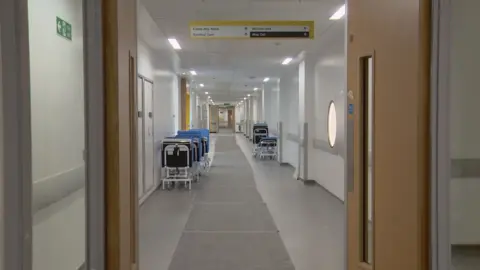Thousands of building snags found at unusable hospital
 BBC
BBCAn unusable children's hospital still had thousands of snagging problems after a health board accepted it as ready, new documents show.
The Sick Kids facility in Edinburgh will not be fully operational until next autumn after last-minute safety concerns stopped it opening in July.
Minutes of the dedicated NHS Lothian board overseeing the project show there were 2,000 snagging issues in May.
This was nearly three months after the health board took over the facility.
NHS Lothian said a snagging list was to be expected on any project of this complexity and would be addressed by the contractor.
They added that IHSL, the private consortium which built the hospital, was responsible for reviewing the quality of the build during the process.
Repayments for the hospital building - the equivalent of about £1.4m a month - started when NHS Lothian moved into the hospital in February.
But minutes of the project board highlighted repeated concerns about defective work.
What snagging issues have emerged?
- fire detectors not properly fitted
- damage to doors
- poor standard of decoration
- lack of quality finishes
- problems with power supplies
The documents also showed more than £2m was diverted from the new hospital's "equipment budget contingency" in order to offset increased construction costs.
A public inquiry to examine safety and wellbeing issues at the new hospital has been called by the Scottish government.
IHSL has pointed out that its works on the hospital were signed off as complete by an independent certifier on 22 February before NHS Lothian moved in.
Daniel Johnson, Labour MSP for Edinburgh Southern, said: "With thousands of outstanding issues months after the NHS had accepted handover of the new Sick Kids hospital, it is clear that this project had critical failings.
"The key question is why it took the government until the 11th hour to step in when it is now clear there were multiple warning signs that the new building was not up to standard.
"The sheer volume of problems, additional payments to the contractor and issues found at the Queen Elizabeth Hospital [in Glasgow] should have prompted a root and branch review of the delivery of this much needed hospital months earlier."
Improvement work
A spokeswoman for the Scottish government said Health Secretary Jeane Freeman received assurances from NHS Lothian that "all relevant compliance issues had been met under its contractual obligations".
"However these assurances subsequently proved to be incorrect and when the issues with the ventilation in critical care in the new hospital came to light, the health secretary suspended the move to the new hospital site in order to ensure patient safety was maintained," she added.
"Patient safety is our utmost priority, and the cabinet secretary will ensure that staff, patients and families are supported, stepping in to address any issues and working with partners to undertake any required improvement work to the current facilities to help continue the delivery of high quality clinical services."
As well as calling a public inquiry, the government is also establishing a national centre of expertise to ensure new builds comply with relevant guidance.

The NHS Lothian minutes, released under freedom of information laws, from May 2017 show the board reporting on how "many quality issues are emerging" and cited issues with damage to doors, power supplies and "a poor standard of decoration/finishing quality".
The minutes then spell out how a dispute between NHS Lothian and IHSL began over standards of construction.
A planned legal challenge against the construction consortium was dropped in favour of paying IHSL £11.6m to settle the outstanding issues - a move approved by the Scottish government.
This was to address concerns over issues such as the site's drainage not working properly and the fitting of automatic fire detection systems in the building's voids.
By May of this year the minutes noted "there are currently 2,000 snags on the system" and pointed to "high level concerns" about the "large number of building related 'defects'".
NHS Lothian's finance director, Susan Goldsmith, said the contract to build the hospital meant the health board did not have the opportunity to review its quality.
"That responsibility lies with IHSL and their supply chain," she added.
"NHS Lothian is given reviewable design data to ensure it provides operational functionality. The Independent Assessor is appointed, by NHS Lothian and IHSL, to verify the building meets the specification and design requirements."
She added that when they became aware of issues, "urgent negotiations" led to the £11.6m settlement.

The new Sick Children's Hospital cost about £150m to build, but its full price tag over the next 25 years, including maintenance and facilities management fees, will be £432m.
In addition to this outlay, £81.7m was spent by NHS Lothian on enabling and equipment works at the site.
This was more than first anticipated and the minutes show that the board, which included senior members of the Scottish Futures Trust government agency, agreed that "£2.3m of the £3.3m equipment budget contingency should be used to balance the capital programme".
Ms Goldsmith, of NHS Lothian said: "Initial estimated budgets for the costs involved in the project, including equipment, were identified in the business case, which was agreed in 2015.
"When it moved into the development phase, the detailed requirements and costs were finalised and in some cases the overall budget could be reallocated. There was no reduction in the amount or quality of equipment sought for the new facility for budgeting reasons."
A spokesman for Multiplex, which was part of the IHSL consortium, said his firm welcomed the public inquiry into the issue and would not be commenting further.
The firm previously pointed out its works on the building "were signed off as complete by the independent certifier on 22 February 2019".
